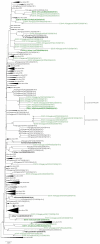A new common mutation in the hemagglutinin of the 2009 (H1N1) influenza A virus
- PMID: 20535229
- PMCID: PMC2880458
- DOI: 10.1371/currents.rrn1162
A new common mutation in the hemagglutinin of the 2009 (H1N1) influenza A virus
Abstract
As the 2009 (H1N1) influenza A virus continues evolving, most mutations appear geographically and temporally confined. However, the latest surveillance data suggests emergence of a new prominent mutation, E391K, in the hemagglutinin (HA) that is globally on the rise. Interestingly, when modelled in the context of the available HA crystal structure, this mutation could alter salt bridge patterns and stability in a region of the HA oligomerization interface that is important for membrane fusion and also a known antigenic site. We discuss occurrence of HA-E391K in global surveillance data and associated clinical phenotypes from Singapore ranging from mostly mild to few severe symptoms, including sporadic vaccine failure. More clinical and experimental data are needed to determine if this mutation could alter the biology and fitness of the virus or if its increased occurrence is due to founder effects.
References
-
- Garten RJ, Davis CT, Russell CA, Shu B, Lindstrom S, Balish A, Sessions WM, Xu X, Skepner E, Deyde V, Okomo-Adhiambo M, Gubareva L, Barnes J, Smith CB, Emery SL, Hillman MJ, Rivailler P, Smagala J, de Graaf M, Burke DF, Fouchier RA, Pappas C, Alpuche-Aranda CM, López-Gatell H, Olivera H, López I, Myers CA, Faix D, Blair PJ, Yu C, Keene KM, Dotson PD Jr, Boxrud D, Sambol AR, Abid SH, St George K, Bannerman T, Moore AL, Stringer DJ, Blevins P, Demmler-Harrison GJ, Ginsberg M, Kriner P, Waterman S, Smole S, Guevara HF, Belongia EA, Clark PA, Beatrice ST, Donis R, Katz J, Finelli L, Bridges CB, Shaw M, Jernigan DB, Uyeki TM, Smith DJ, Klimov AI, Cox NJ. Antigenic and genetic characteristics of swine-origin 2009 A(H1N1) influenza viruses circulating in humans. Science. 2009 Jul 10;325(5937):197-201. Epub 2009 May 22. - PMC - PubMed
-
- Novel Swine-Origin Influenza A (H1N1) Virus Investigation Team, Dawood FS, Jain S, Finelli L, Shaw MW, Lindstrom S, Garten RJ, Gubareva LV, Xu X, Bridges CB, Uyeki TM. Emergence of a novel swine-origin influenza A (H1N1) virus in humans. N Engl J Med. 2009 Jun 18;360(25):2605-15. Epub 2009 May 7. Erratum in: N Engl J Med. 2009 Jul 2;361(1):102. - PubMed
-
- Kilander A, Rykkvin R, Dudman SG, Hungnes O. Observed association between the HA1 mutation D222G in the 2009 pandemic influenza A(H1N1) virus and severe clinical outcome, Norway 2009-2010. Euro Surveill. 2010 Mar 4;15(9). pii: 19498. - PubMed
LinkOut - more resources
Full Text Sources
Research Materials






